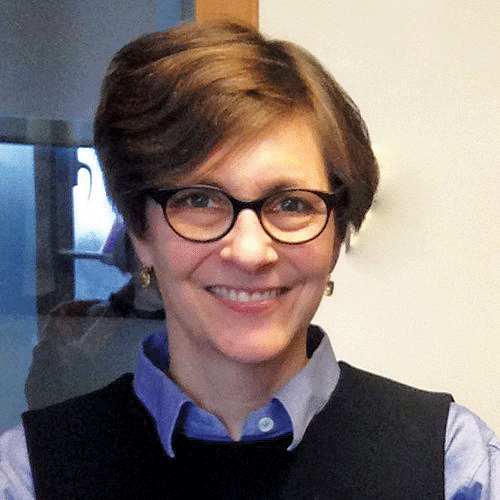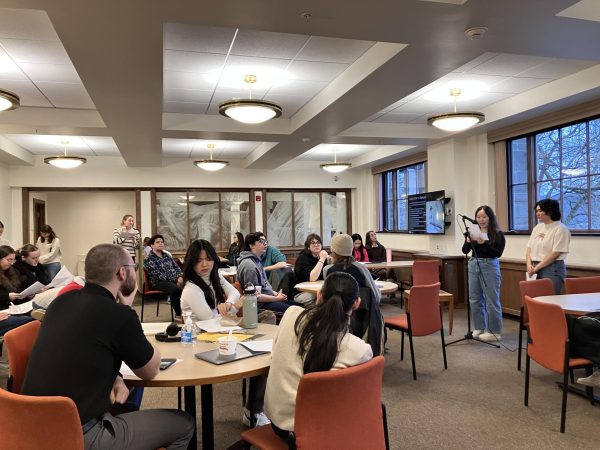Art History’s Haunted House

Evonne Levy, Associate Professor of the History of Art at the University of Toronto, addressed the Colgate community on October 11.
Students, professors and members of the Hamilton community gathered in Little Hall’s Golden Auditorium on October 11 for a lecture by Evonne Levy, Associate Professor of the History of Art at the University of Toronto. Levy, whose interests are Renaissance and Baroque art, contended that political analysis is embedded in art historians’ analyses; her lecture explored this concept as well as intellectual history, art history and historiography. Levy discussed what people conclude about objects, what art historians understand and believe to be purposeful and why such things matter when looking at and contextualizing art.
Levy began her lecture by discussing church decorations in seventeenth-century Italy. During this time, the church had a massive economic, moral and ritual hold on society – its artistic projects were incredibly important. Over time, however, the processes of secularization, enlightenment and modernization greatly influenced the church, which receded from society and became less relevant. Levy studies this consequence of the seventeenth century through art to show that the study of art history is truly relevant and matters to modern day contextualization. She articulated that the analysis of a style of a work of art is influenced by one’s political beliefs; even if unconscious reflection is embedded with a political motivation, modern art history is created by people with belief systems and a point of view.
Levy then segued into her own autobiographical account, which began with the story of Jacob Burckhardt, a man considered to be the first modern art historian. Burckhardt was Swiss, anti-clerical, skeptical and anti-modernist. He viewed Jesuits as a pernicious invading force in Europe. In 1841, Burckhardt spent time in Germany’s Cologne Botanical Garden, where he sketched the unfinished Cologne Cathedral. Burckhardt believed the garden was haunted by both Jesuits and French botanists, spirits and big forces of European history. He also saw the spirit of Germany in the cathedral: there was a movement to complete the architectural structure, and it was believed that finishing the uncompleted building would bring about a cultural unification to unify Germany. Despite this feeling, Burckhardt felt the need to screen out historical context when confronting art. Levy said that art and architecture have important political implications, and to fail to recognize these political implications is to fail to understand the artwork.
Part two of the lecture was titled “My Berlinerzimmer – 1993.” Levy discussed her dissertation on why controversial and consequential works of art or architectural structures mattered, and the effect and purpose of propaganda. The controversy surrounding the construction of the Chapel of St. Ignatius (1695-1699) piqued Levy’s interests. She discovered the motivations that the Jesuits had to build this chapel, and that it was not a spontaneous or autonomous project; rather, it was a calculated effort to create the appearance of devotion, even when the Jesuits were skeptical that this work of art could create an emotional appeal to its viewers.
Following her studies on this matter, Levy became interested in the conflicts and debates over what to do with empty Nazi buildings after the Berlin Wall came down in 1989. She found that Germans felt the need to use these buildings because of a responsibility to deal with their past and the fact that the buildings were well-built, however, they remained highly fraught works of architecture. Levy next began to wonder, if selling postcards or propaganda of the national socialists is illegal, does that make the Nazi buildings illegal? She questioned what it means to call a work of art propaganda, and the implications that this term holds; she concluded that propaganda helps us think about authorship in a different light.
An additional constructive point Levy made was the neutralizing of once-controversial structures or entities. She discussed neutralizers of the church (those in denial of the ways in which religious art was produced) and how they generate meaning when situated in historical and modern contexts, which obscured the positions of the art historians who studied these works. To neutralize Baroque works of art and architecture was to resist their placement in the art historical context, to deconstruct the spirits and ideologies that once haunted these structures. In addition, art historians had to overcome the stigma of a controlling Catholic church and the absolutism of the time, which led to the creation of new historical prejudices of art historians.
Modern studies of art historians have shifted their attention from the institutions that organized the art to the artists and the focus of the artists who created the art. For example, one would reinterpret Caravaggio as an artist and a revolutionary autonomous from the church, not merely an agent of the church. In conclusion, propaganda when used to discuss art is used to evoke distance from the work of art. Propaganda is ubiquitous, and the neutralization of art works and art objects was killing history of Jesuit art. One cannot emphasize the religious aspects of the art work without acknowledging the political influences; to do so would lose a critical part of the work. It is these histories of interpretation that may be neutralized or distanced from historical context that continue haunting spirits today.
Contact Caylea Barone at [email protected].
Caylea Barone is a senior from LaGrangeville, New York concentrating in environmental studies and art and art history with an emphasis in studio art. She...






